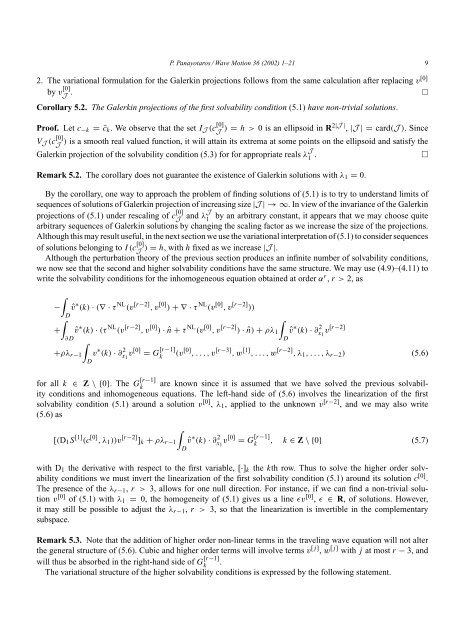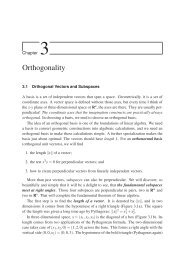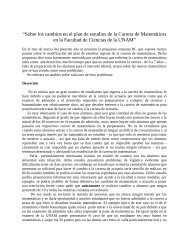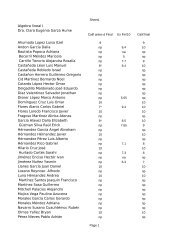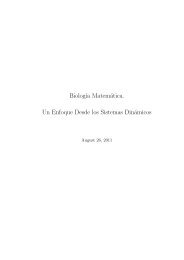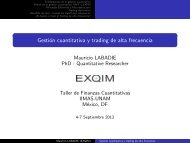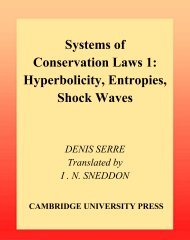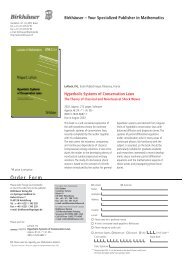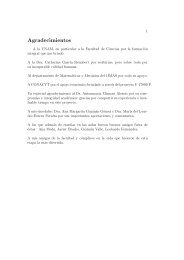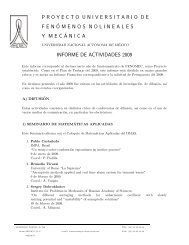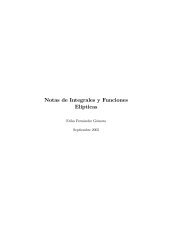An expansion method for non-linear Rayleigh waves - FENOMEC
An expansion method for non-linear Rayleigh waves - FENOMEC
An expansion method for non-linear Rayleigh waves - FENOMEC
You also want an ePaper? Increase the reach of your titles
YUMPU automatically turns print PDFs into web optimized ePapers that Google loves.
P. Panayotaros / Wave Motion 36 (2002) 1–21 92. The variational <strong>for</strong>mulation <strong>for</strong> the Galerkin projections follows from the same calculation after replacing v [0]by v [0]J .Corollary 5.2. The Galerkin projections of the first solvability condition (5.1) have <strong>non</strong>-trivial solutions.Proof. Let c −k =¯c k . We observe that the set I J (c [0]J ) = h>0 is an ellipsoid in R2|J | , |J |=card(J ). SinceV J (c [0]J ) is a smooth real valued function, it will attain its extrema at some points on the ellipsoid and satisfy theGalerkin projection of the solvability condition (5.3) <strong>for</strong> <strong>for</strong> appropriate reals λ J 1 .□Remark 5.2. The corollary does not guarantee the existence of Galerkin solutions with λ 1 = 0.By the corollary, one way to approach the problem of finding solutions of (5.1) is to try to understand limits ofsequences of solutions of Galerkin projection of increasing size |J |→∞. In view of the invariance of the Galerkinprojections of (5.1) under rescaling of c [0]J and λJ 1by an arbitrary constant, it appears that we may choose quitearbitrary sequences of Galerkin solutions by changing the scaling factor as we increase the size of the projections.Although this may result useful, in the next section we use the variational interpretation of (5.1) to consider sequencesof solutions belonging to I(c [0]J ) = h, with h fixed as we increase |J |.Although the perturbation theory of the previous section produces an infinite number of solvability conditions,we now see that the second and higher solvability conditions have the same structure. We may use (4.9)–(4.11) towrite the solvability conditions <strong>for</strong> the inhomogeneous equation obtained at order α r , r>2, as∫− ˆv ∗ (k) · (∇ ·τ NL (v [r−2] ,v [0] ) +∇·τ NL (v [0] ,v [r−2] ))D∫∫+ ˆv ∗ (k) · (τ NL (v [r−2] ,v [0] ) ·ˆn + τ NL (v [0] ,v [r−2] ) ·ˆn) + ρλ 1 ˆv ∗ (k) · ∂x 2 1v [r−2]∂DD∫+ρλ r−1 v ∗ (k) · ∂x 2 1v [0] = G [r−1]k(v [0] ,...,v [r−3] ,w [1] ,...,w [r−2] ,λ 1 ,...,λ r−2 ) (5.6)D<strong>for</strong> all k ∈ Z \{0}. The G [r−1]kare known since it is assumed that we have solved the previous solvabilityconditions and inhomogeneous equations. The left-hand side of (5.6) involves the <strong>linear</strong>ization of the firstsolvability condition (5.1) around a solution v [0] , λ 1 , applied to the unknown v [r−2] , and we may also write(5.6) as∫[(D 1 S [1] (c [0] ,λ 1 ))v [r−2] ] k + ρλ r−1 ˆv ∗ (k) · ∂x 2 1v [0] = G [r−1]k, k ∈ Z \{0} (5.7)Dwith D 1 the derivative with respect to the first variable, [·] k the kth row. Thus to solve the higher order solvabilityconditions we must invert the <strong>linear</strong>ization of the first solvability condition (5.1) around its solution c [0] .The presence of the λ r−1 , r > 3, allows <strong>for</strong> one null direction. For instance, if we can find a <strong>non</strong>-trivial solutionv [0] of (5.1) with λ 1 = 0, the homogeneity of (5.1) gives us a line ɛv [0] , ɛ ∈ R, of solutions. However,it may still be possible to adjust the λ r−1 , r > 3, so that the <strong>linear</strong>ization is invertible in the complementarysubspace.Remark 5.3. Note that the addition of higher order <strong>non</strong>-<strong>linear</strong> terms in the traveling wave equation will not alterthe general structure of (5.6). Cubic and higher order terms will involve terms v [j] , w [j] with j at most r − 3, andwill thus be absorbed in the right-hand side of G [r−1]k.The variational structure of the higher solvability conditions is expressed by the following statement.


